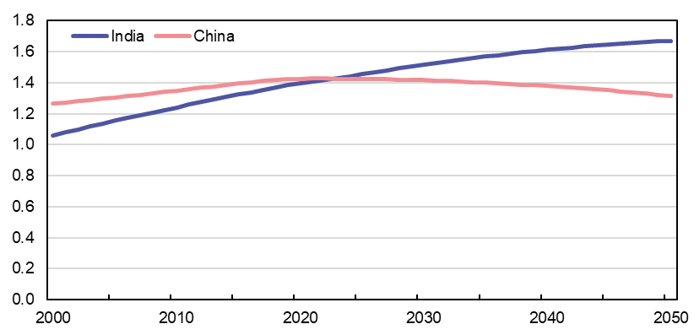BOFIT Weekly Review 32/2022
India on verge of surpassing China as world’s most populous country
According to the UN’s latest forecast of global population growth, India’s population will be larger than China’s next year. In 2023, both countries will have populations of roughly 1.4 billion people, which together would represent about a third of the planet’s human population.
China’s population is expected to begin shrinking at some point this year. The decline is largely a reflection of China’s low fertility rate, which has remained below two births per woman since the 1990s. To achieve a stable replacement rate over the long term, a country’s fertility rate must be 2.1. China’s fertility rate fell to 1.2 last year.
China pursued its one-child policy, introduced in 1980, for nearly four decades. Restrictions on family size have been relaxed in recent years in order to slow the rapid greying of the Chinese population. In 2016, couples in urban areas were granted the possibility of having two children, and last year the limit was increased to three children. Despite the policy shift, the number of births has continued to decline.
India’s fertility rate has also been falling in recent years. The current fertility rate is 2.0, which is less than the long-term stable replacement rate. India’s population is expected to keep growing for a while, but at a fairly slow pace. Its population should begin to decline in the second half of this century after reaching the 1.7 billion level.
As with China in recent decades, the engine of population growth in India has been reduced mortality due to longer lifespans. The UN predicts that India’s average life expectancy will rise to 72 years next year, which is about 10 years longer than at the start of the millennium.
India’s increased life expectancy is particularly a reflection of improvements in healthcare that have lowered infant and maternal mortality rates, as well as deaths from infectious diseases. The government has pushed on multiple fronts ranging from vaccination to improved hygiene in prevention and care for diarrhoea, a traditional cause of infant mortality in India. Thanks to these changes, deaths of children under one year of age has been halved in India over the past two decades.
Longer lifespans and falling births imply rapidly ageing populations for both India and China. Under the UN model, the current population median ages of 28 years for India and 39 for China will each rise by about 10 years by 2050.
Population trends for China and India (in billions).
Sources: UN World Population Prospects Database and BOFIT.